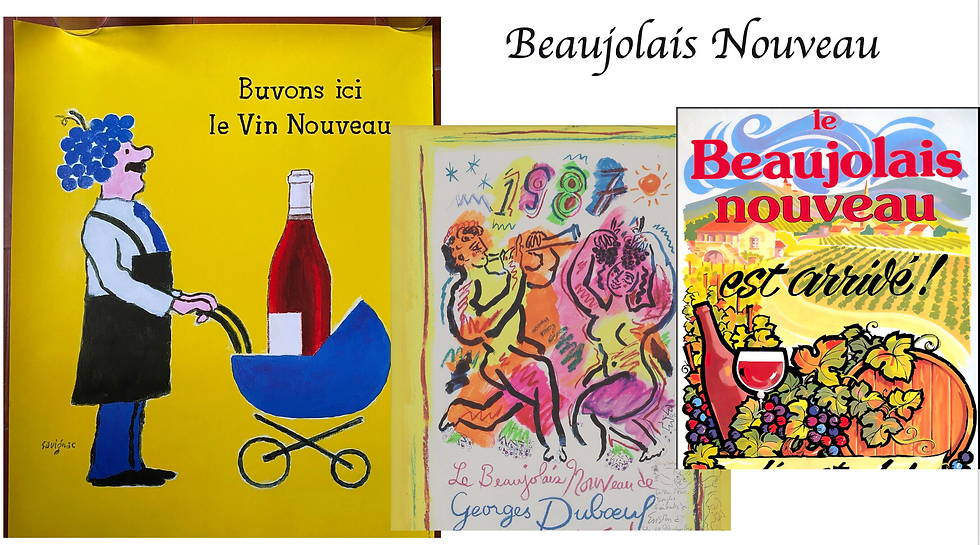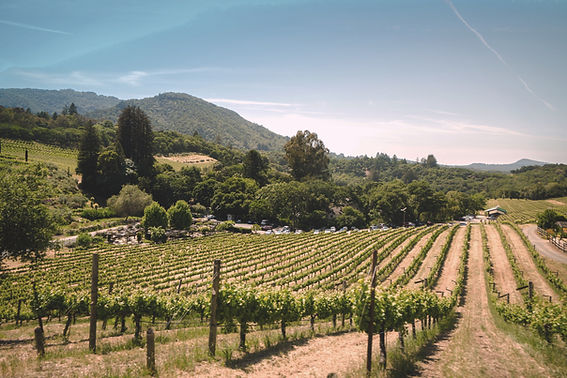Understanding Beaujolais: From Gamay to the Crus and Nouveau
- Victoria Daskal

- 9 hours ago
- 4 min read

To celebrate Beaujolais Nouveau Day—the third Thursday in November—I wanted to share some insights into Beaujolais as a region. There’s a lot more here than just the fresh, early-released Nouveau. From the different styles and quality levels to the geography, history, and people who have shaped it, this overview gives some context to what makes Beaujolais unique and why this annual celebration matters.

Geography: Beaujolais vs Villages vs Cru Beaujolais
Beaujolais sits between Burgundy to the north and the Northern Rhône to the south. It’s inland, with a moderate climate and no influence from the sea. This is very much a region focused on the Gamay grape.
There are 12 appellations in the region.
Beaujolais AOC
This is the entry-level appellation. Grapes can come from anywhere, but they’re mostly sourced from the southern area with limestone and limestone–clay soils.
Beaujolais Villages AOC
A step up in the quality pyramid. This includes a collection of villages, mostly to the north. The rules are a little stricter and the quality can be slightly higher, though the jump is not always dramatic.
Both Beaujolais and Beaujolais Villages produce red, rosé, and white wines. Reds and rosés are made from Gamay; whites from Chardonnay.
The 10 Crus of Beaujolais
At the top of the quality pyramid are the crus — ten appellations in their own right, all producing only red wine:
Saint-Amour
Juliénas
Chénas
Moulin-à-Vent
Fleurie
Chiroubles
Morgon
Régnié
Côte de Brouilly
Brouilly
These are considered the highest quality expressions of Beaujolais.
Differences Between the Crus (Quick Overview)
Moulin-à-Vent and Morgon: more powerful, structured, concentrated. Côte du Py in Morgon is especially renowned.
Fleurie: often the more delicate, floral, lighter style.
Chiroubles: highest altitude, giving freshness, bright acidity, and good flavour development.
Terroir and Soils in Beaujolais
Beaujolais has over 300 soil types. While people often generalize that the south is limestone and the north is granite, the reality is much more nuanced. Different altitudes, aspects, granites, sands, and clays all play a role.
Gamay is quite vigorous, and in the south it can create lighter, simpler wines. In the north, the variation in soils produces more concentrated, higher-quality wines, which is why the crus are located there.
Approximate production breakdown:
95% red wine
2% white wine (mostly Chardonnay, and growing)
3% rosé (also growing)
Tiny amounts of sparkling wine and pét-nat
White Beaujolais is increasing as global demand for white wine rises. Rosé is still small but expanding. Recently, Beaujolais Nouveau rosé was allowed; there is still no white Nouveau.

The Gamay Grape
Gamay’s full name is Gamay Noir à Jus Blanc, meaning black-skinned Gamay with white juice. This distinguishes it from another Gamay type with pink juice, which is not used here.
Gamay is a Burgundian grape. Its parents are Pinot Noir and Gouais Blanc — the same combination that produced Chardonnay. In that sense, Gamay and Chardonnay are siblings, which makes their coexistence in the region natural.

A Brief History of Beaujolais
Beaujolais has nearly 2,000 years of wine history. Vines grew here during the Roman era, and several cru names reflect this:
Juliénas refers to Julius Caesar.
Brouilly and Côte de Brouilly refer to the Roman lieutenant Brulius, who was gifted land on Mont Brouilly.
Viticulture continued through the medieval period.
1395: Philip the Bold’s Ban on Gamay
Gamay was planted throughout Burgundy at that time. Philip the Bold banned it from Burgundy, calling it a bad, disloyal grape. The real reason was that Gamay is vigorous, high-yielding, and easier to grow than Pinot Noir, resulting in large quantities of lower-quality wine. It threatened Burgundy’s reputation.
He forced producers to uproot it and allowed it only in Beaujolais, which cemented the region’s identity.
20th-century milestones
1936: Several crus became AOCs.
1937: Beaujolais AOC was created.
1951: Beaujolais Nouveau was officially codified.
1970s: Georges Duboeuf heavily promoted Nouveau internationally.
1988: Kermit Lynch highlighted producers making more terroir-driven, less industrial wine, calling them the “Gang of Four”:
Marcel Lapierre
Jean Foillard
Jean-Paul Thévenet
Guy Breton
Recent developments
A major soil study revealed over 300 soil types. In 2018, Beaujolais was recognised as a UNESCO Global Geopark. This has encouraged efforts toward gaining premier cru status within certain crus, such as Fleurie.

Styles of Wine Found in Beaujolais
Rosé
Made from Gamay, usually direct press, pale pink, crisp, dry, with good acidity. Sometimes lees-aged for roundness.
Beaujolais Blanc
Beaujolais Blanc and Beaujolais Villages Blanc (no cru whites) are made from Chardonnay. Usually unoaked or lightly aged in older barrels, often with lees ageing and malolactic conversion for a creamy texture.
Carbonic and Semi-Carbonic Maceration
A hallmark of Beaujolais.
Carbonic maceration:
Whole clusters harvested by hand
Fermentation begins inside intact berries (intracellular)
Creates very fruity, bright, bubblegum and strawberry kirsch or banana-like notes
Very little tannin
Ideal for chilled, easy drinking
This is the classic style for Beaujolais Nouveau.
Semi-carbonic maceration:Some berries are crushed by the weight of the bunches, producing a mix of carbonic and traditional fermentation. This adds a little more structure.
Cru Winemaking
Crus tend to avoid full carbonic maceration. They may use whole-bunch fermentation, partial destemming, and ageing in old barrels for complexity without overt oak.
Pét-nat and Sparkling
Made via the ancestral method. Light fizz, sometimes cloudy, fruity, and fun. Occasionally labelled as perlé rouge.

Beaujolais Nouveau Today
Released the third Thursday of November. Fun, vibrant, uncomplicated, and great with charcuterie, duck, hearty dishes, and cheeses. Best drunk chilled and within the first six months.
Beaujolais Nouveau is only labelled under Beaujolais AOC or Beaujolais Villages AOC. There is no such thing as a cru Nouveau.
It’s made from Gamay that was probably still on the vine six to eight weeks earlier. It’s very fresh and released on the third Thursday of November at one minute past midnight. It’s meant to be enjoyed casually: easygoing, thirst-quenching, chilled, simple, and fun.
Producers based in the crus often make Nouveau as well — they just can’t label it as such.

Beaujolais is often pigeonholed as simple or cheap, but in reality it’s a region of enormous diversity: 300 soil types, 10 distinct crus, multiple wine styles, fascinating history, and an ongoing rediscovery of its terroir. Beaujolais Nouveau gets one day of celebration, but the rest of the region offers wines worth exploring all year long.




Comments